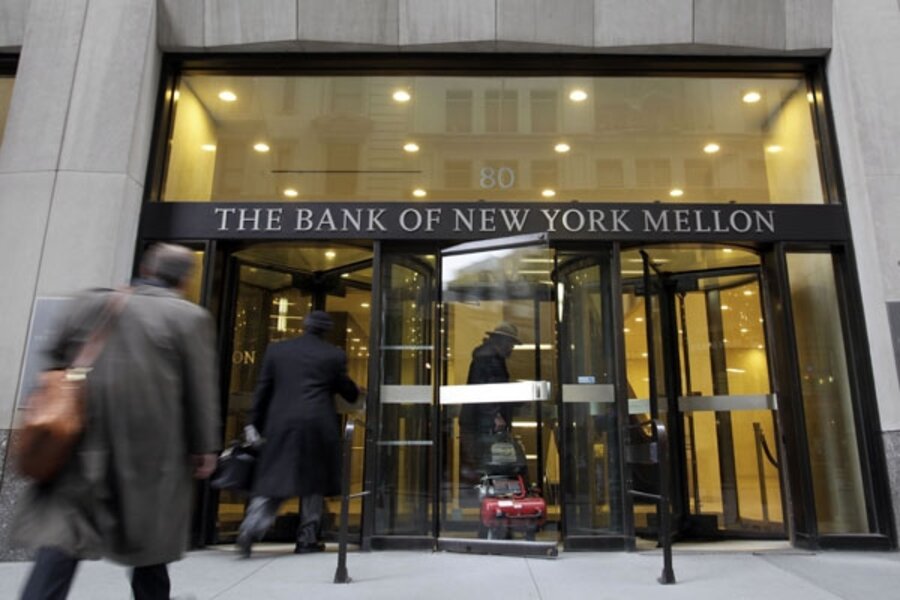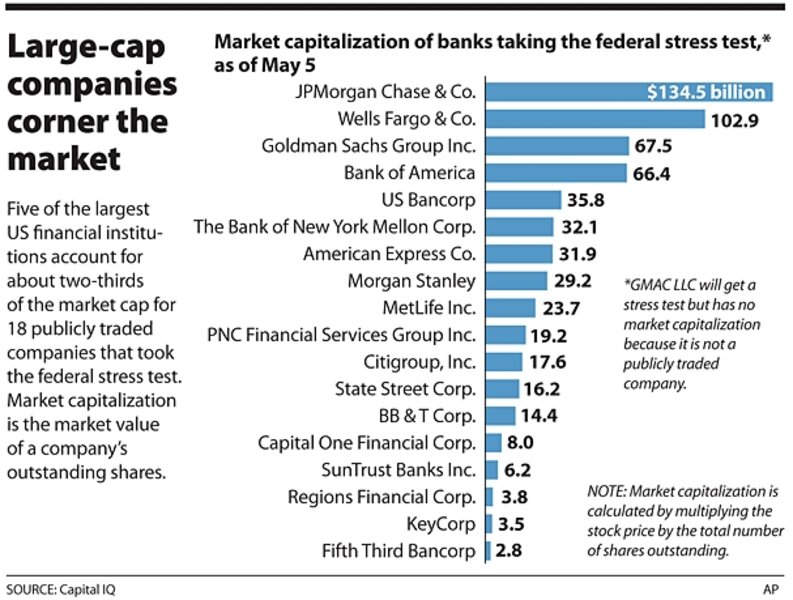Five things the bank stress tests will and will not do
Loading...
The mood surrounding the vital banking industry has actually been getting less stressful, even as federal regulators prepare to unveil the results of “stress tests” on major banks.
Investors have been sending positive signals about banks. Financial stocks have risen by double digits since Treasury Secretary Timothy Geithner announced the stress tests on Feb. 10. It’s an indication that fears of an ongoing economic meltdown are receding.
Yet the stress tests remain important. Banks still face big losses on their loans, and most experts say that fixing banks is fundamental to an economic recovery. The stress test is one of the most important federal policies to set banks right.
So here’s a cheat sheet for the stress tests – five things to expect, and five things that won’t happen as the results are released.
What the stress test will do:
1. The results will provide a tangible report card on specific banks.
Analysts will debate how reliable the assessment is, but for the first time in this financial crisis, federal regulators will be saying publicly where the 19 biggest bank holding companies stand.
The word tangible is important. One key measure of each bank’s health is whether it has enough “tangible common equity,” essentially common stock, on its balance sheet. That stock is a vital cushion – a reserve that can be tapped if need be to cover losses.
In the test, regulators are looking at the likely losses on bad loans for each bank and seeing if banks have enough capital on hand to cover them. Tangible stock is one key way to measure capital, and the regulators may ask banks to raise more of it to ensure their health in the next couple of years.
2. No bank will 'fail,' but the results will divide apparent winners from losers in the industry.
Already, investors have formed their own opinions on how healthy the various banks are, but the official view of regulators could have an impact if they differ from the prevailing views.
On Wednesday, the Associated Press cited sources briefed on the results, who said that American Express, JPMorgan Chase, and Bank of New York Mellon will not be asked to raise more capital. By contrast, Citigroup, Bank of America, and Wells Fargo all will be asked to raise money to fill potential gaps in their capital.
3. The test results are expected to help keep credit flowing for consumers and businesses.
“The main purpose is to make sure that the banks have a more than sufficient capital buffer,” so they can make new loans, says Brian Bethune, an economist for IHS Global Insight, who tracks the financial sector.
“Banks might say, ‘We’re fine, thank you very much,’ ” Mr. Bethune says. Raising new capital is a costly process that many banks would rather avoid right now. But regulators are trying to ensure that banks not only can survive the current storm of mortgage and other defaults but also continue to lend as loan losses devour banks' capital.
4. The government's ownership stake at some banks might expand.
Banks deemed to need more capital will have the opportunity to raise it from private investors. But a key alternative is to draw more capital from the Treasury’s Troubled Assets Relief Program (TARP) in the form of preferred shares.
Preferred shares are different from common stock in that preferred-share owners receive an extra dividend in addition to typical stock dividends, but they do not have the same rights as common stock owners, such as votes in corporate affairs.
Banks could also choose to convert their preferred shares into common stock. Doing this would lessen the burden on banks by eliminating the need to pay the extra dividend that preferred stocks generate. But it would increase federal ownership of all the common shares in a given bank, given that the government would then have more of a say in the running of the bank.
5. The tests could lead to pay caps for some bankers.
Banks that meet capital needs by taking new TARP money will need to abide by congressionally mandated caps on compensation.
What the stress test won’t do:
1. The results won’t prove that banks are fundamentally sound.
The industry generally is in an impaired condition, because so many bank loans are mortgages with real estate as collateral, and property values have been hit so hard in many cities.
Some banks would be unable to raise money from private investors – a marketplace verdict of insolvency. Government aid may help them return to health, but a recovery for the industry also depends on where the economy and real estate markets head from here.
Moreover, critics say the Treasury and Federal Reserve made the test criteria too soft. Bank health is being assessed according to a couple of scenarios, but many economists say the reality could easily prove more stressful than the test envisioned in its “adverse” case.
2. The process won’t fix the economy.
There’s wide agreement that a strong economic recovery won’t occur without a healthy banking system to supply credit. But financial experts predict a slow process, with banks gradually improving, and households undergoing their own gradual financial repair process, getting out from under a decade of rising debt.
3. The tests won’t end debate about whether President Obama’s policy on banks is the right one.
The stress tests and capital boosts are a central piece of the president’s plan to nurse the banking system back to health, ideally without needing to take full national control of more big firms, as the government did last fall with AIG.
Critics worry that the approach will delay economic recovery, by propping up weak banks without truly restructuring them. They also warn that the cost of the mess will keep rising – to unaffordable levels – the longer the economy remains mired in recession.
Other economists say the Obama-Geithner plan has a good shot at working, and that a more aggressive approach involving nationalization of some large banks might backfire, disrupting banks that are on the road toward healing with federal help and oversight.
“We’ve kind of threaded the eye of the needle,” Mr. Bethune says. “The most critical phase [of the crisis] was probably the last three or four months of 2008."
4. The initial results aren’t likely to cause the TARP money to run dry.
At some point, Obama may need to go back to Congress for more bank rescue money, beyond the initial $700 billion in the TARP request. But the White House and Congress both see how unpopular Wall Street bailouts are with voters.
By some estimates, $100 billion or more remains in the TARP. The International Monetary Fund estimates that US banks may require about $275 billion in new capital. But the stress-test results aren’t expected to suggest that banks need that big of a capital boost.
5. The test won’t remove the need for a new approach to regulating banks.
Even if the program gets banks through the current crisis, an overhaul is needed to reduce the risk of this kind of crisis recurring, finance experts widely agree.






